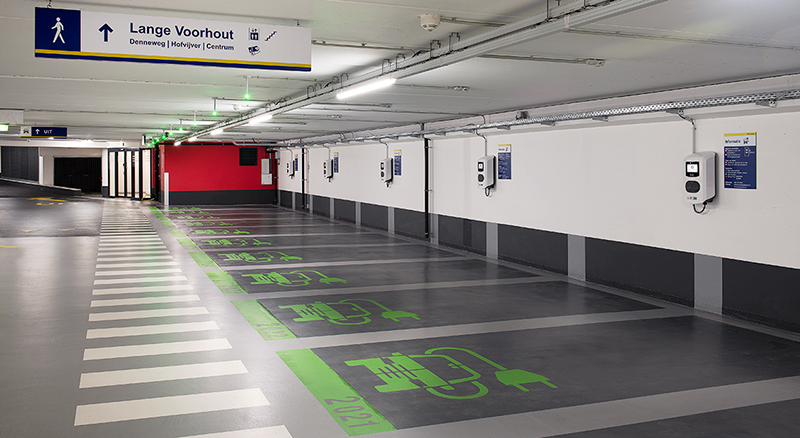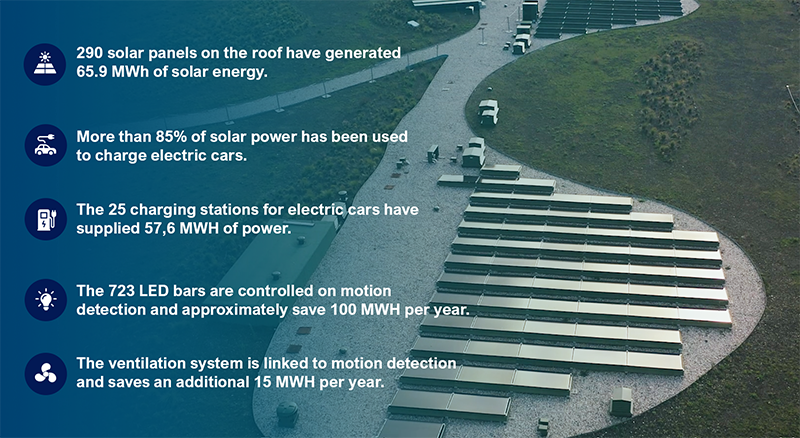We do everything we can to make mobility more sustainable and to optimize traffic flow in cities on a daily basis. One of our strategic pillars for the next 4 years is therefore to reduce our impact on the environment. Together with our employees and clients, we continuously look at the steps we can take in developing environmentally friendly parking solutions. The environment in which the parking facility is located, optimum traffic flow and the needs of the user are central to this.
Sustainability starts at Interparking already in the design phase
Car traffic and parking facilities are an important part of our mobility chain. A parking location that is properly integrated into this chain can shorten the journey of the driver and make the journey more pleasant. An efficient inflow, through and outflow of traffic for both cars and pedestrians is essential. This requires high demands on the design and layout in and around the parking facility. With our smart approach to accessibility and signage we reduce search traffic. In addition, we work together with architects and urban planners to contribute to a more beautiful cityscape by taking the cars from the street.
Energy-efficient installations
All owned car parks are equipped with LED lighting and motion detection to reduce power consumption. Previously, with traditional lamps, about 90% was lost to heating the lamp instead of illuminating the room and it had a much shorter life. By using motion sensors, the light is automatically switched on when a person or vehicle enters the car park, which saves a lot of energy, especially at night. In the Boulevard car park in Scheveningen, the ventilation system is also linked to the motion detection. Depending on the number of movements, additional energy is also saved here, especially at night.
Generate your own energy
Interparking Boulevard is the first Interparking car park in the Netherlands that is equipped with solar panels to generate its own energy. Due to the good results, we are looking at the possibilities of further applying this at other locations. In addition, we are currently investigating the use of batteries at the locations with solar panels to store energy if there is a surplus. We can then use the surplus again if there is a shortage. This will relieve the power grid.
Minimize CO2 emissions from search traffic
For our parking facilities, we always go for the shortest route and to minimize the movements of parkers. This means that we want to lead the customer as quickly as possible from home – to the car park – to their destination. We do this by giving the customer the oppurtunity to reserve a parking space in advance. This minimizes search traffic in the city. Our car parks are optimally designed with efficient routing, and the parker finds a free parking space as quickly as possible via the parking guidance system.
The rise of the electric car
Governments are focusing on making mobility more sustainable. The electrification of the vehicle fleet plays an important role and the car industry is responding to this with substantial investments. For example, well-known car brands have already indicated that their cars will be fully electric from 2030. Iwan Fernhout, real estate manager at Interparking Netherlands: “In 2020 the number of electric cars increased by 38% and in 2022 we will see that more and more private individuals will purchase an electric car. The main motivations are to contribute to a better climate, governmental incentives and reduction of the purchase value of these vehicles. To take advantage of electric driving, you must of course be able to rely on the fact that you can easily charge the car. That is why a lot of preparations are currently being made to increase the current capacity in our inner-city parking garages. In Rotterdam this takes place in the Markthal (70) and Lijnbaan (30) car parks and in Amsterdam in the IJDock (32) car park. The capacity of the Museumkwartier car park in The Hague has recently been expanded to 20 points and the capacity has been further prepared to eventually offer 64 loading places. Later this year, the loading capacity at an additional eight locations will be prepared for further expansion.”

Image: New charging stations, Interparking Museumkwartier in The Hague
A practical example: car park Boulevard
Car park Boulevard is a good example of a car park that has been optimally preserved. This parking garage with 700 parking spaces is located directly on the boulevard in Scheveningen. The green roof is equipped with 290 solar panels and the green electricity that comes from this is distributed over all energy-efficient installations of the parking garage, including the lighting, ventilation and the electric charging points. In addition, the parking garage has been designed in such a way that the traffic flow is optimal, even during the busy summer months. With interchangeable lanes at the entrances and exits, we can create an extra entrance or exit at any time and via the parking guidance system a free parking space can be found quickly via the shortest route, so that the visitor does not have to drive in circles unnecessarily.

Image: savings in the Boulevard car park (2021)